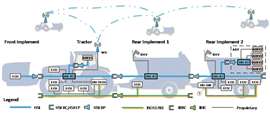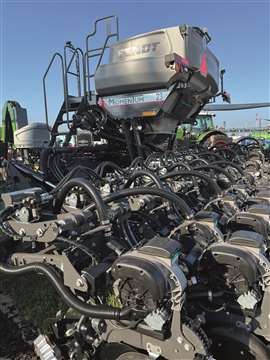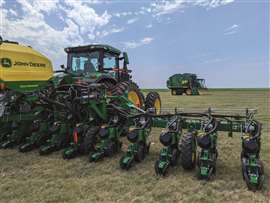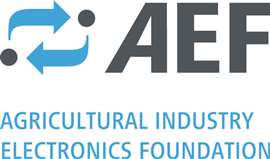The ISObus transformation
06 October 2023
Ag and construction equipment engineers collaborate for future standard
 Source: Agricultural Industry Electronics Foundation
Source: Agricultural Industry Electronics Foundation
The Agricultural Industry Electronics Foundation (AEF) has organized a cross-industry collaboration of heavy equipment manufacturers to build a new High Speed ISObus (HSI) standard, ISO 23870. The organization said the members of Joint Working Group 16 are committed to sharing technical knowledge to put the farm machinery on the path to full automation.
A core value of AEF is collaboration – or “sitting at one table,” in the words of Peter van der Vlugt, former AEF chairman and general manager/CTO – Innovation Center Europe at Kubota Holdings Europe.
 Peter van der Vlugt
Peter van der Vlugt
When the Germany-based AEF was founded in 2008, its vision was to bring about working solutions through collaboration with global experts to help realize optimum results in a complex world.
“Our goal is to develop a standard that works in the field with certification processes, and to develop new functionalities on top of ISObus,” said van der Vlugt. “In the end, this all aligns to work for farmers that use multi brands so their mixed-fleet can truly be plug and play.”
To get the work done, AEF has assembled a cross section of experts.
“Whether the customer has a green tractor and plugs in a red implement or vice versa, it should simply work,” said van der Vlugt. “We developed this along the last decade and a half, to a certain set of guidelines and certification processes as an industry.”
The need for a digital transformation has required AEF investigate where ISObus fits in. With the long-term goal of making field automation possible, the organization said there is a larger need for faster speeds, which means transforming ISObus for interconnected systems.
Limitations of ISObus
Developed nearly three decades ago, ISObus refers to the ISO 11783 standard, the nervous system of agricultural equipment that connects tractors to implements and the operator’s systems, including displays and joysticks. With ISObus, AEF said, machines work together as a system better than each component can work on its own.
 The current ISObus standard allows today’s smart tractors to talk with their equally intelligent implements. A new standard is currently being developed for autonomous equipment in agriculture and construction. (Photo: Becky Schultz)
The current ISObus standard allows today’s smart tractors to talk with their equally intelligent implements. A new standard is currently being developed for autonomous equipment in agriculture and construction. (Photo: Becky Schultz)
The current standard is robust, said AEF, and delivers enough performance for today’s applications, but it has physical and data limits. As a relatively slow system, the organization believes that the current ISObus standard can be stretched to at least another 10 years. However, the next generation of ISObus will be required for the advanced implements of the near future.
“ISObus is still serving the industry very well and will continue to do so for years to come,” said Andrew Olliver, AEF chairman and Global Precision Technology Partner manager at CNH Industrial, “but the industry has recognized that ISObus is holding back the development of far more demanding systems that aim for higher performance and accuracy of control.”
“If you look to how fast everything goes in terms of digital transformation, not only sharing data from the machines to cloud platforms, but also sharing data between tractors and implements, there’s a real need to do it faster,” said van der Vlugt.
HSI is expected to deliver greater precision for the future, which will help reduce the amounts of fertilizer and chemicals applied to fields.
Examples of future technology that could use HSI include command and control at the row level on a large planter or individual nozzles on a sprayer, remote process viewing with advanced digital cameras, enabling higher levels of automation and more.
Teamwork
AEF began researching High Speed ISObus in 2014, and as it moved into the development phase, additional expertise was needed.
In 2020, Dave Smart, retired senior staff engineer and John Deere fellow, and the current AEF HSI team leader, along with Greg Kittle, manager of Product Safety and Compliance for the John Deere Construction and Forestry Division, saw a standard for the future, one that would meet the needs of higher speeds, faster communication, and sensors to develop even smarter combinations. The standard would serve the agricultural and construction industries.
“The idea, initially, was to do something high speed,” said Kittle. “I wanted something like ISObus in earthmoving machines so that we could accept various technologies, no matter where they might be developed. The High Speed Bus, or what we now call the High Speed ISObus, as an interconnected system, is essential for us as a foundational component to add on, or to support other technologies.”
AEF was a natural partner, with a long history of developing guidelines and transitioning those guidelines into standards. AEF’s opinion was that it just made sense.
“Why would one industry develop another connector type than the other industry? Let’s see what we can share,” said van der Vlugt. “It saves us generating another standard, so let’s team up.”
Working Group 16
Since the start of 2021, members of various ISO technical committees have met regularly to answer the question: What are our commonalities and what are our goals?
 In the AEF HSI project team, 25 members meet regularly to define agriculture requirements for a new ISO standard. (Photo: Chad Elmore)
In the AEF HSI project team, 25 members meet regularly to define agriculture requirements for a new ISO standard. (Photo: Chad Elmore)
The cross-industry meetings have allowed engineers to collaborate on the initial drafts of the new standard where agriculture, earthmoving, mining, forestry, on-road truck and trailer all meet to solve a similar need. That work will come together as a new set of ISO standards, in Joint Working Group 16, under ISO TC 127 / SC 3 (lead) and ISO TC 23 SC19.
Each technical committee is responsible for an industry component. ISO TC127, for example, has been working to automate server-to-server communication for topographical data.
“That’s foundational because it allows for things like job site task automation,” said Kittle.
In the AEF HSI project team, 25 members meet regularly to define agriculture requirements. Joint Working Group 16 allows the teaming up as there are a large number of industries that all need the high speed network and same basic communications protocol.
“This is how we’ll end up with a high-quality and usable standard that future proofs, at least to a large degree, what each industry wishes to do with it on their journey,” said Kittle. “It’s on a journey from nothing to full automation. We could do this independently, but it would be incredibly costly, and we would be limited in the technology that we could apply to get those things done.”
Okay to be different
The team recognizes that there will be some industry-specific areas that are not common across all applications. Their intent is to allow that to occur.
“At the very top of this building block, are the applications, and the applications for ag, they’re different than construction, they’re different from mining, they’re different from on road truck and trailer, and that’s okay,” said Smart. “Those individual industries will address those features, but it’s again building on that same common foundation.
It’s a puzzle; quite a few pieces we have to create, and make sure they fit together, but many others will be leveraged as existing standards.”

Stepping up
Foundations such as AEF develop certification processes and procedures that their members can implement.
“This is not going to be one very large standard, it will be multiple standards that interoperate and build upon each other,” said Eric Moughler, Product Safety and Compliance, Caterpillar, and project leader of Joint Working Group 16. “It’s going to be a very large undertaking, over multiple years, and will be delivered in a sequence over time.”
The AEF is writing guidelines for their members in preparation for the new standard. The standard is one thing, but having a certain set of compliancy is the second level where the group will ensure that different products work together.
“The standards are usually open for interpretation,” said van der Vlugt. “And if you put a bunch of engineers together and you start to discuss certain topics in the standard, they will have different opinions on how to implement them. That’s the nature of engineering. In the end, you get products that are not completely compatible. This is where the AEF is invaluable.”
ISO standardization is a lengthy process that could take many years.
“The urgency becomes a matter of corporate need, readiness, willingness, and ability to begin to deploy earlier than the actual final standardization based on the group’s work, based on the AEF guidelines, and based on our early development of an ISO standard,” said Smart. “Each individual company will need to make that call. Every one of these industries is looking to improve efficiency, automation and the path to autonomy.”
Collaborating together has become the new norm; the market is multi-branded, especially in Europe, said AEF. In the U.S., the market is different because of decades of brand loyalty, but that may be changing.
“Farmers are being much more conscious about what’s out there, and that there are possibilities of buying a different brand,” said van der Vlugt. “They are also starting to recognize that ISObus opens up a whole new world where multi-branded, fast-moving, fast-controlling equipment is working together.
“Looking beyond 2030, maybe even towards 2040, we see this increasing data demand. We see this digitalization coming up. We see also in our industry, a lot of robotics manufacturers that are coming up now. To get all this equipment in the future interoperable in the field; that’s what the farmer wants, and the grower wants, and the contractor wants, and the agronomist wants, even. It all has to work together.”
The new HSI will meet the future demand for more data and control between different brands so an implement controlling a tractor or vice versa, or a combination in the field of multiple machines, will be the reality. It’s going to be quite the undertaking for the industry’s volunteers.
“It’s going to be a complex story in the next decade, for sure,” said Smart.
Article provided by the Agricultural Industry Electronics Foundation.
STAY CONNECTED



Receive the information you need when you need it through our world-leading magazines, newsletters and daily briefings.
CONNECT WITH THE TEAM







